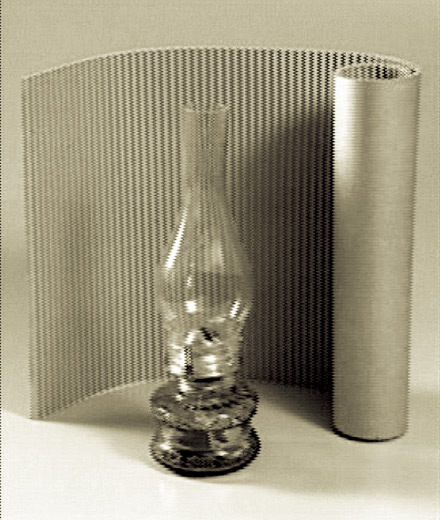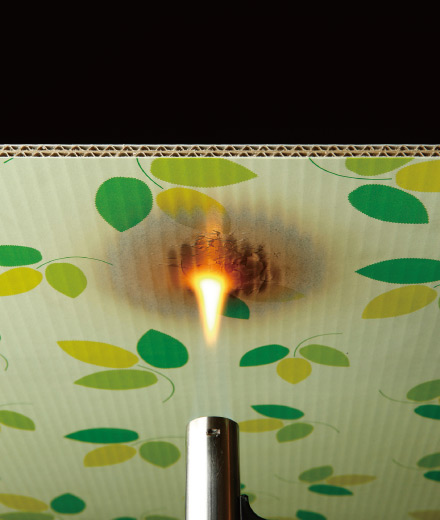History of Rengo
-
Changing times and the history of Rengo
- Teijiro Inoue makes
Japan's first corrugated board -

Corrugated board used to wrap around and protect a lamp
- 1909
- World War I
Establishment of various new industrial facilities
- Teijiro Inoue made up his mind to become an independent self-employed businessman (and later made April 12, the day of his decision, the company's Foundation Day)
Established Sanseisha in Shinagawa, Tokyo, setting up Japan's first corrugated board business
Coining of the Japanese term for single faced corrugated board, "danboru" which is still used today
- 1920
- Great Kanto Earthquake
Taisho Democracy
-
Five companies merged to form Rengo Shiki K.K., capitalized at ¥2 million
Acquired Nippon Seishi and renamed it the Chifune Plant
The head office, Tokyo Plant and other facilities were destroyed by fire after the earthquake, and the head office was relocated to Osaka
Began sale of applied products (larval silkworm raising boxes and clothing boxes)
- 1930
- Showa Financial Crisis Expansion of exports February 26 Incident
World War II
-
Completed construction of the Yodogawa Plant, which employed an integrated production system, from containerboard to corrugated board
Met a wider range of demand that included home appliances, canned foods, bottled beer, ceramics, and clothing
Established new plants and subsidiaries in Korea, Taiwan and China
Formed a capital tie-up with Tokyo Electric (current Toshiba)
- From wooden boxes
to corrugate packaging - 1940
- Pacific War
Promulgation of the Constitution of Japan
Outbreak of the Cold War
Production to meet military demand under wartime economic control
-
Six domestic plants were destroyed by fire during air raids, and overseas assets were lost
Resumed production to meet consumer needs and developed new demand for corrugated boxes for frozen whale meat and canned foods
Obtained a listing at stock exchange and increased capital to ¥10 million
- Sudden increase in
corrugated board production together
with rapid economic growth - 1950
-
San Francisco
Home electric
Peace Treaty
"We are no longer in
the postwar period."
appliance boom -
Corrugated boxes were increasingly used for mandarin oranges, apples, and frozen fish.
Modernized production equipment to meet growing demand
Opened Research Laboratory (later, Central Laboratory)
“Ruten” boom as Teijiro Inoue's autobiography was adapted for TV and film
-

Advertising poster for corrugated packaging
- 1960
- Trade liberalization
Tokyo Olympic
Games
Japan attains world's
second largest GNP - Built Tonegawa Mill, as well as new corrugated plants
Introduced technology from the United States as the functions of corrugated boxes diversified
Developed GRAVIAN and other pre-printed corrugated boxes
- 1970
-
Japan World
Second Oil Crisis
Exposition
Plan for the
remodeling of the
Japanese archipelago
First Oil Crisis -
Rengo Shiki K.K. renamed Rengo Co., Ltd.
Developed CORFLEX five-color pre-printed corrugated box
Developed continuous running technology for corrugator operation
Developed and commercialized “Fingerless Single Facer”
Exported Rengo's technologies for producing paperboard and corrugated board
- 1980
- Recession caused
by the strong yen
Prolonged
economic boom
Cold War ends with
collapse of
the Berlin Wall
Land and stock price boom - Built a series of new corrugated plants
Expanded business to cover nonwovens and other peripheral areas
Opened new office in Singapore for overseas expansion
- 1990
- End of "bubble
economy"
Multiple recessions
Great Hanshin-
Awaji Earthquake
Creation of the
euro currency
“Lost Decade” and
zero interest policy -
Ventured into overseas business with Malaysia as a start
Opened Packaging Technical Center
Acquired Fukui Chemical Industry, an affiliated company
Incorporated Howa Sangyo into Rengo Group to enter the flexible packaging business
Acquired Settsu to reinforce the integrated paper and corrugated board production system
-

Fire-retardant corrugated board RAFEP that does not catch fire easily even though it is made from paper
- 2000
-
"No-holds-barred
structural reforms"
Terrorist attacks on
the United States
Massive tsunami off
SumatraBeijing 2008 Olympics
Steep rise in the
prices of crude oil
and other resources
Global financial crisis -
Made Marusan Paper Mfg. Co., Ltd. a group company
Bolstered energy conservation equipment, including biomass incineration power plant
Merged Kawasaki Plant with Katsushika Plant to become folding carton production location on East Japan
Installed a photovoltaic power generation system at the Kyoto Plant
Shin-Kyoto Division commenced integrated production of corrugated board/boxes and folding cartons after merger of the Kyoto and Katsura plants
Rengo's 100th anniversary (April 12, 2009)
Made Nihon Matai Co., Ltd. a group company, and entered into the heavy duty packaging business
- 110th anniversary since
corrugated board made
its appearance in Japan - 2010
-
World Expo 2010
Shanghai
Great East JapanEarthquake
Abenomics
-
New paper mill, a joint venture in Vietnam, begins full-scale operation
Completed construction of the Fukushima-Yabuki Plant which uses photovoltaic power generation to supply all the plant's daytime electricity needs
Completed construction of the Shin-Sendai Plant in about a year after its predecessor, the Sendai Plant, suffered extensive damage in the Great East Japan Earthquake
Completed construction of the Shin-Nagoya Plant, which features one of Japan's largest seismically isolated automated warehouses
Completed PM8 for linerboard production at Marusan Paper Mfg.
Made Tri-Wall Holdings Limited a group company
Completed conversion of Kanazu Mill's PM2 to produce both corrugating medium and linerboard
Made Toppan Containers Co., Ltd. a group company (current RG Containers Co., Ltd.)
- 2020
- Spread of COVID-19
Tokyo 2020 Olympics Games
- Made Taiko Paper Mfg., Ltd. a group company , and entered into the kraft pulp and kraft paper business
Opened Yodogawa Logistics Center as a logistics center for containerboard
Installed biomass boiler facility for power generation at Tonegawa Division
Relocated Matsuyama Plant and established Ehime-Toon Plant
Expo 2025 Osaka, Kansai, Japan
- Teijiro Inoue makes
